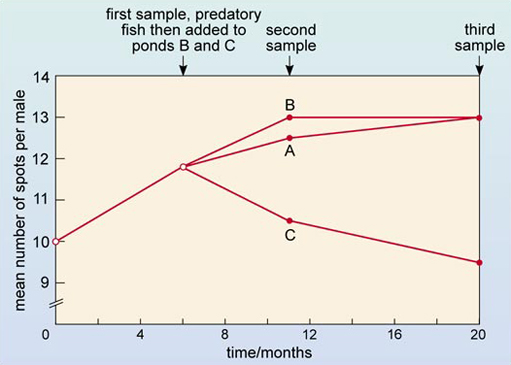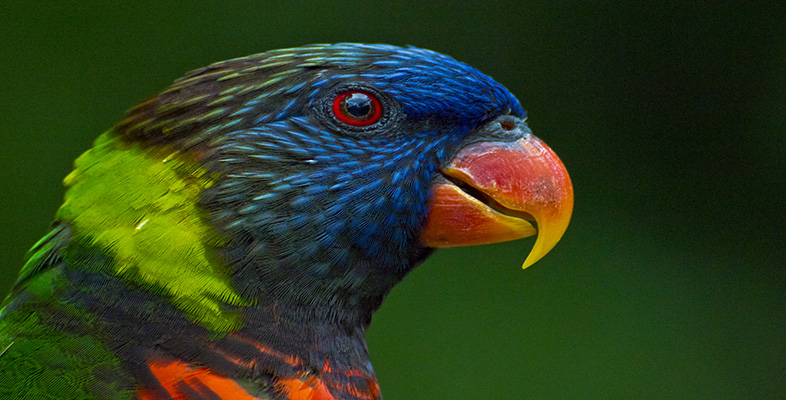3.5 Inheritance
The adaptive explanation for bright coloration in male guppies given above can only be correct, and can only have evolved by natural selection, if male coloration has a heritable basis. Direct evidence that it is a heritable character is of two kinds. First, a wide variety of decorative guppies have been bred for sale on the aquarium market. Such forms could not have been produced if male coloration were not heritable. Second, if samples of guppies are taken from different Trinidadian streams and bred in the laboratory, they yield male offspring that resemble their fathers; stocks derived from predator-free streams are more brightly coloured than those from predator-rich streams.
Our discussion so far of the biology of guppies has concentrated on whether the necessary and sufficient conditions for natural selection exist in this species. The fact that they do strongly supports the hypothesis that male coloration has evolved by natural selection. However, this does not constitute a direct, rigorous test of the hypothesis. A series of experiments carried out during the 1970s by the American zoologist John Endler did put the hypothesis to such a test.
In one of his experiments, Endler built several artificial ponds and stocked each with a population of guppies derived from several different localities in Trinidad. At this stage, guppies were the only fish in the ponds. There was considerable variation among males in the number of their spots, but the mean number of spots per male across all the populations at the start of the experiment (time=0 months) was 10 (Figure 3). He left the ponds alone for six months, then sampled the populations in each of the ponds and counted the number of spots on the male guppies. He found that the mean number of spots per male had increased to 11.8 (Figure 3).

-
What adaptive explanation can you suggest for this increase in male spot number?
-
In the absence of any predatory fish, natural selection had favoured an increase in spot number. The more heavily spotted males had more offspring because they were more attractive to females.
Six months may well seem a remarkably short period of time for such a change to have come about. Indeed it is, although it is not the actual time that is important. The guppy is iteroparous, and over the course of six months, Endler's artificial populations were able to reproduce several times.
-
Why is the number of breeding episodes more significant than the time in months?
-
Because at each breeding episode females choose the most attractive males with which to mate. The more attractive males, i.e. those that have more spots, father more offspring and as spots are inherited, those offspring have more spots.
Having sampled his populations at six months, Endler divided them into three groups (A, B and C). He added to each group C pond one individual of a fish called Crenicichla alta, which is a particularly voracious predator of guppies. To each group B pond he added six individuals of another predatory fish called Rivulus hartii, which does not prey on guppies. No fish were added to the group A ponds. The ponds were then left alone for a further five months (time for guppies to breed several more times), at which point he sampled them again and counted the number of spots on the male guppies.
-
From Figure 3, how did the mean number of spots per male differ between the time of the second sample (at 11 months) and the time of the first sample (at six months) for the three groups of ponds?
-
The values for groups A and B had increased slightly from 11.8 to 12.5 and 13.0 spots, respectively. However, the value for group C had declined, from 11.8 to 10.5. The populations had therefore diverged in terms of mean male spot number.
In the final phase of his experiment, Endler left his populations for a further nine months (time for several more generations), after which he carried out a final analysis of male spot numbers. At 20 months, the populations had diverged even more than at the time of the second sample, with groups A and B now averaging 13.0 spots per fish and group C averaging 9.5 (Figure 3).
-
Do the results summarized in Figure 3 support the hypothesis that, through natural selection, the presence of predatory fish affects the number of spots on male guppies?
-
Yes, they do. Several guppy generations after the introduction of predators to some ponds, male guppies in those ponds that contained voracious predators had fewer spots than those in ponds that contained either no predators or predators that are innocuous to guppies.
Question 3
The purpose of the group C ponds was to see what the effect would be on the guppy populations of adding a voracious predator after several generations in which there had been no predation. What do you think was the purpose of the group A and B ponds?
Discussion
The purpose of the group A ponds was to show what happened over the same period of time in the absence of predators. The change in the number of spots in the group C guppies might have taken place anyway, whether or not the predators had been introduced. The group A ponds allowed Endler to check on this possibility. {The group A ponds therefore served as 'controls' for the 'experimental' group C ponds. A 'control' is an important feature of scientific experimental procedure. It enables the investigator to be sure that any change taking place in the 'experimental' set-up is due to the factor that has been experimentally changed, and not to some other factor which has not been accounted for.} The group B ponds allowed Endler to check whether any change observed in the group C ponds could have been due, not so much to the addition of a fish that preys on guppies, but to the addition of any other species of fish or even any other species of predatory fish (whether it preyed on guppies or not). {So again, the group B ponds serve as 'controls' for the 'experimental' group C ponds.}
This example has illustrated four important points about natural selection. First, provided the three necessary and sufficient conditions listed in Section 1 are met, the form of a character can change from generation to generation. Second, the form of the character that results from natural selection represents a trade-off between the various ways in which that character affects the survival and reproduction of individuals. Third, natural selection can lead to a quite marked change in the form of a character in only a few generations. Finally, it shows that the theory of natural selection can be tested by carrying out experiments.
